Guided by the Stars
A behind-the-scenes look at the journey of the Hōkūle‘a , one of the most epic sea-faring adventures of modern times
Archie Kalepa and his 12-man crew were a few miles off the coast of Madagascar, mentally preparing for the infamous currents of the Mozambique Channel, when they decided they should stop for a prayer. It was fall of 2015, and the crew was on the outer edge of a storm so fierce it had shut down that country’s namesake port. Even Hōkūle‘a, the 62-foot Hawaiian voyaging ;canoe they’d just sailed from the island nation of Mauritius, was denied entry, along with international cargo ships and commercial fishing boats that made their hand-built vessel look as small as a rubber ducky.
Huddled on the deck of Hōkūle‘a, bracing themselves for the impromptu voyage to South Africa’s Cape of Good Hope, one of the crewmen, a native Hawaiian, blew into a prayer shell. The moment was nothing short of cinematic, says Kalepa, a retired lifeguard who’s spent 30 of his 51 years patrolling some of Hawaii’s most legendary breaks and beaches and is now 's , or caretaker. “At the closing of the ritual,” he recalls, “we looked to the starboard side of the canoe, toward Madagascar, and all of these whales started jumping around us.”
As the cetaceans frolicked in the heaving Indian Ocean, Kalepa’s co-captain and mentor, Nainoa Thompson, asked him to estimate the size of the rollers moving toward the coast. “The swells were far enough apart that we could sail them,” says Kalepa. “But they looked like mountains. We could feel their magnitude every time we rolled down the back of one.” Kalepa told Thompson the swells must be 40 feet high, adding, “By the time they break on shore, they’re probably 60 feet.”
It was just one of many pivotal moments the crew has faced while at sea. That’s because Thompson and Kalepa are two years into one of the most epic sea-faring adventures of modern times. Using ancient methods of oceanic navigation, the Hōkūle‘a is currently sailing around the world, a 47,000-mile voyage that, when it finally arrives back home in Honolulu, will have visited 85 ports and 26 nations. (As of the end of May, it was currently making its way up the East Coast, with plans to arrive in New York City June 5-18. You can .)
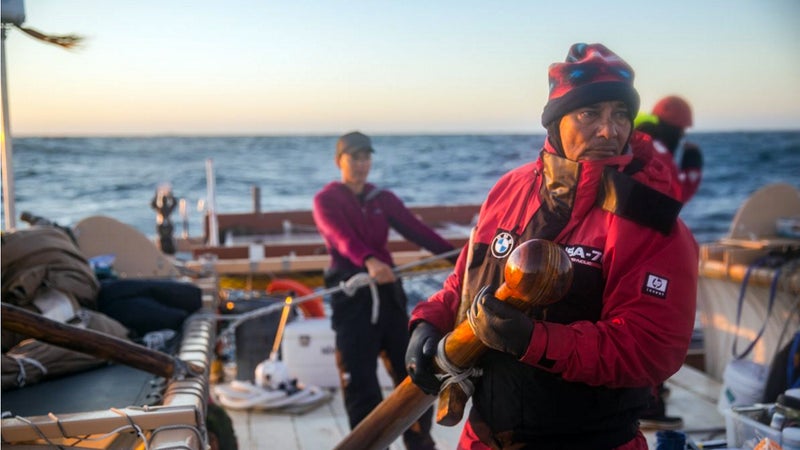
The overarching purpose of the voyage is two-fold: to demonstrate the importance of making a change for a more sustainable future and to honor and pass along ancient Pacific Islander seafaring traditions. To achieve the former, the rotating crew of some 200 men and women have been visiting local communities and working with educators around the globe. Fulfilling the second part of the mission is more difficult.
Hōkūle‘a’s crew never relies on compass, GPS, speedometer, or sea charts. There’s no radar or sonar equipment onboard. The crew doesn’t even wear watches. Instead, they steer their esteemed canoe, mark time, and track their progress using and developed by their Polynesian ancestors.
Nature’s Original Map Readers
Looking to the sky to travel across an ocean takes years to comprehend and thousands of hours to master. Thompson, who’s one of the world’s finest celestial navigators, describes the cryptic art as a “mental construct,” with 32 equally spaced “star houses that come out of the ocean and go back into the ocean” with day-to-day consistency. “If you can identify the stars as they rise and set,” he says, “and if you have memorized where they rise and set, you can find your direction.”
But studying glowing white specks in the sky is only part of the equation. Celestial navigation, known as The Star Compass, requires a fathoms-deep understanding of wind and wave behavior. Austin Kino, a Hōkūle‘a crew member, apprentice navigator, and ambassador, describes it like this: “I know that the Belt of Orion always rises in the East and sets in the West, no matter where I am in the world. But when it’s cloudy, we can’t rely on just the stars.” Instead, says Kino, he and his peers memorize their orientation within the stars and combine it with other factors, namely wind behavior, which, in turn determines wave patterns. “Learning the waves is the hardest thing,” he says. “It’s a system that used to be taught to kids as young as five years old by uncles and fathers. It takes a lifetime. To feel the water and be able to adjust course based on how it’s hitting the hull—�ٳ�’s how you become a master.”
Built for Distance, Bound by Ohana
While intuiting the nature of waves is something crewmembers learn, they receive an important assist from centuries of Polynesian craftsmanship. The Hōkūle‘a was built in the mid 1970s on Oahu by artist Herb Kane, anthropologist Ben Finney, and waterman Tommy Holmes. This unlikely trio wanted to learn how the Hawaiian Islands were discovered, experience the ways in which Polynesians plied the high seas, and re-introduce the Hawaiian people to the kind of vessel that their ancestors navigated from Polynesia for nearly 2,000 years.
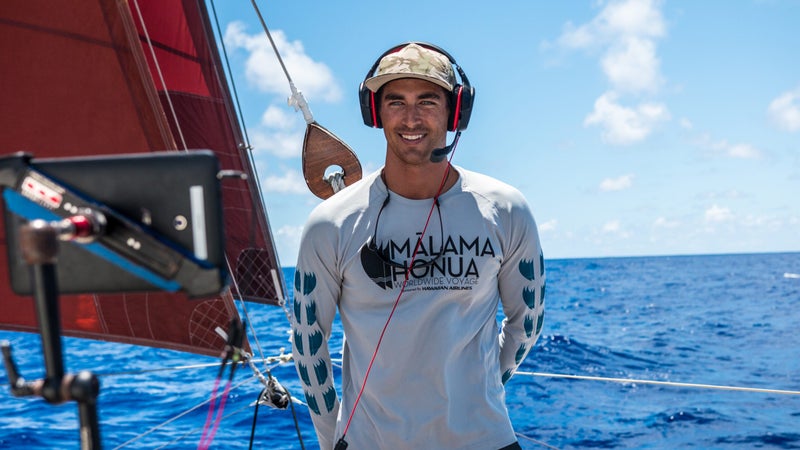
Hōkūle‘a has three sails (a main, a mizzen, and a jib), two hulls, and a platform that sleeps 12 just as their forebears slept—on deck with a view of the firmament. True to custom, the Hōkūle‘a’s hull is lashed together with thousands of feet of rope—six miles of it, to be exact—and immeasurable amounts of muscle. The result is a sailing canoe �ٳ�’s stable yet supple, able to withstand crashing waves while flexible enough to let sailors feel the ocean.
Crewmembers feel the water in more literal ways, too. When nature calls, for example, they step into a harness and hang from the side of the canoe. “Deep-sea voyaging like this is very rustic,” says Kino. For this reason, life aboard the Hōkūle‘a requires deep camaraderie, suspension of judgment, and mutual respect. “We’re on four-hour shifts, performing 30 different roles, from cooking to navigating to safety,” says Kino. “We have to leave our issues on land and treat each other like family,” or ohana.
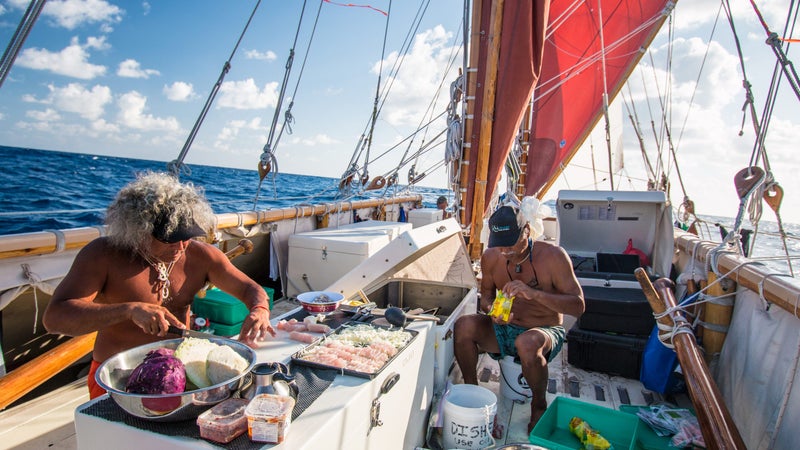
One way co-captains Thompson and Kalepa ensure an atmosphere of ohana is to assemble a diverse crew of both genders. Historically speaking, deep-sea voyaging was a mostly male pursuit, but everyone involved in the project agreed this was a tradition worth changing. “There’s a calmness when women are onboard,” says Jenna Ishii, a 31-year-old crew member and apprentice navigator, who has sailed four legs of Hōkūle‘a's voyage and helps manage it while on land. “With the right mix, the canoe becomes more like a household, with peace and cohesion. It’s not quite half-male, half-female yet,” she says, “but we’re getting there.”
Sailing for Malama Honua—Our Island Earth
Hōkūle‘a, of course, is more than just a finely built replica or showpiece. Ask anyone with deep ties to Hawaii and they’ll tell you it’s a cultural touchstone. By 1976, when she made her maiden voyage to Tahiti and back, roughly six centuries had passed since the colonization of the Hawaiian Islands. Despite being home to the world’s finest wave-riders, swimmers, paddlers, spear-fishermen, and lifeguards—what Islanders call watermen and waterwomen—Hawaii’s tradition of canoe-building, celestial navigation, and wave piloting were all but lost. Hōkūle‘a’s triumphant voyage to Tahiti changed that.
Kalepa, a seventh-generation Hawaiian, was 12 years old when the canoe returned to Waikiki. “I was paddling for a canoe club on the North Shore of Oahu, and I heard that it was going to be arriving,” he recalls. “I ditched summer school that day and my friends and I paddled out in a small canoe. I remember looking at all the boats greeting it. Tugboats were spraying water through firehoses. You couldn’t help but feel the mana, or spirit, of what the crew had accomplished. I don’t think anyone realized it at the time, but it really sparked Hawaii’s sense of pride and culture.”
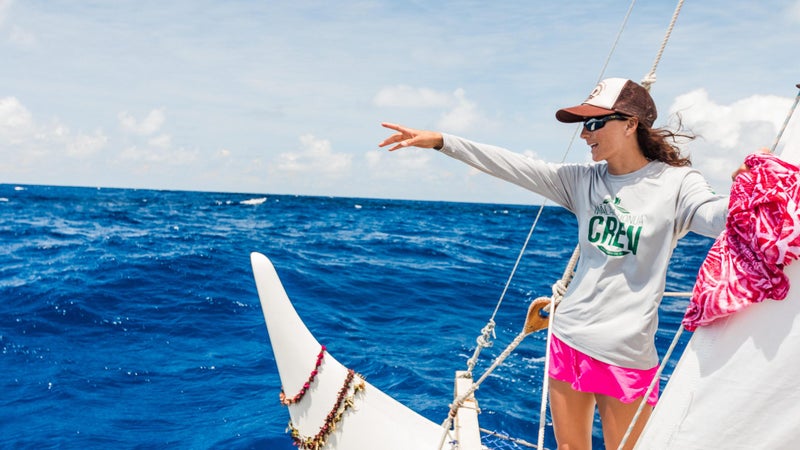
Indeed, Hōkūle‘a helped revive a part of Hawaii’s history and became central to the lives of generations old and young. Growing up on Oahu, kids like Kino and Ishii were taught about Hōkūle‘a the way mainlanders might learn about Columbus and the Mayflower, staging grade-school plays and coming to understand that Polynesia’s celestial navigators were the astronauts of their time. With that knowledge came the ancient lesson of Malama Honua, or to care for our Earth. That means living sustainably, the way that Hawaiians and their ancestors did in simpler times. Think of Malama Honua as one component of what Hawaiians call the Aloha Spirit—an intangible but practicable combination of energy and joy and sharing.
“Hōkūle‘a helped revive a part of Hawaii’s history and became central to the lives of generations old and young. Growing up on Oahu, kids like Kino and Ishii were taught about Hōkūle‘a the way mainlanders might learn about Columbus and the Mayflower.”
Hōkūle‘a speaks to all of those ideas, says Kalepa. “It has allowed us as a race of people to understand who we are.” Sailing Hōkūle‘a around the world has brought the notion ofAloha to communities around the world, raising awareness not just about Polynesian sea-faring history, but about the importance of looking after the land and oceans we so often take for granted. “When you live on an island, you become very connected with nature,” says Kalepa. “We want to share that with the rest of the world, to help people tune into where we’re from and where they’re from. Hōkūle‘a sends a message that says, ‘Let’s step back and look at what we as humans can do to save the earth. Earth can only take so much of itself, so maybe as we move into the future, we should stop and learn from our past.’”
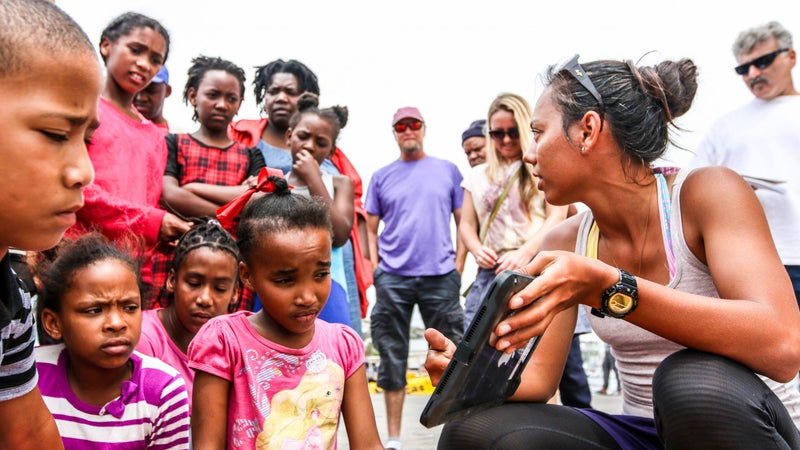
is honored to partner with the and support the Hōkūle‘a crew in their ambitious endeavor. The Hōkūle‘a represents a large part of OluKai’s company mission – honoring and preserving Hawaiian culture and traditions. We are proud to outfit the crew with footwear, receive their invaluable feedback, and support the voyage through our non-profit, the . To learn more about Hōkūle‘a or to track their journey, please visit the Hōkūle‘a's .

